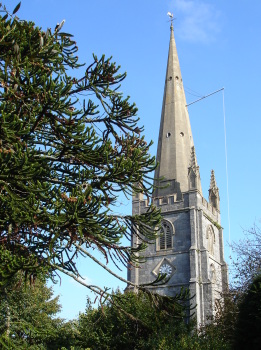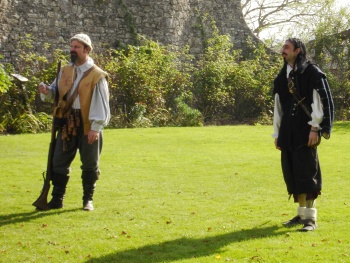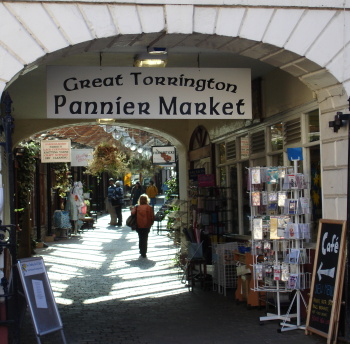
From the path that runs along the top of Castle Hill on the south-western edge of the town one can see the picturesque River Torridge valley far below.
Torrington's medieval castle was built in the early 13th century in a dominating position on top of this hill. The original castle keep is no longer standing; indeed it is so flat that a bowling green occupies the site today.
Great Torrington was the setting in 1646 for one of the last major set-piece battles of the first of the two English Civil Wars, and its outcome led to the collapse of the Royalist cause in the West of England.

By late summer 1645 the supporters of the monarch were rapidly losing their stranglehold on the West Country with the steady westward advance of Fairfax and Cromwell's recently formed New Model Army. By the middle of October they had reached East Devon, and Tiverton Castle fell without much resistance on October 19th. The next major target was the Royalist stronghold of Exeter which was being blockaded by Fairfax's men when news spread that the enemy had taken up a defensive position under the command of Lord Hopton in Great Torrington to the north. Fairfax decided on an immediate challenge, leaving Sir Hardress Waller to continue the siege of Exeter.

The Parliamentarians under Thomas Fairfax entered Torrington from the east on the rainy night of February 16th where they encountered stiff opposition form Lord Hopton's Royalist forces. It is estimated that more than 15,000 men on foot and on horseback took part in the fierce fighting that ensued. The Royalists were heavily outnumbered as Fairfax's army was ten thousand strong. Not realising that the Royalists had used the church to store their powder magazine, Fairfax ordered that some two hundred prisoners be held in the building. In the heat of the battle a stray spark ignited the powder, causing eighty barrels of gunpowder to explode, blowing the roof off the church and killing the hapless prisoners and many Parliamentarian soldiers in the vicinity. A web of incandescent lead narrowly missed General Fairfax who was some distance away in Market Square.

Contemporary accounts suggest that the explosion may have been started deliberately: a parliamentary report on the night's events even went as far as to claim that one of the prisoners was found with a lighted match in his hand after the explosion, confessing before he died that he had been offered a reward of £30 by Lord Hopton for this act of desperation. Wardman sees the hand of Cromwell's propaganda machine at work here, preferring the accidental conflagration explanation [Wardman].
In the mayhem and panic following the devastating explosions, Lord Hopton and what remained of his army withdrew from Torrington and fled westward into Cornwall where they remained until March 14th when Hopton surrendered to Fairfax who allowed him sanctuary in exile on condition he disbanded the western army.
The parish church, having been violently destroyed in the Battle of Torrington, was substantially rebuilt in 1651 and restored again in 1864, after which it bore no resemblance to the 17th century building.
A large cobbled mound outside the church door is said to contain the remains of the prisoners buried after the explosion in a mass grave.

Each February a torch-lit procession is held to commemorate Fairfax's victory, with many participants attired in the costume of the day. This annual event is just one of the many ways the town celebrates its historic association with England's bloody Civil War: there is the permanent Torrington 1646 exhibition with outdoor demonstrations of 17th century weaponry and armour, the Torrington Cavaliers who dress and act out the parts of imaginary characters from that period, frequent Sealed Knot re-enactment events, and a Civil War Heritage Trail.

It is my personal impression that the Torrington folk revelling in the town's past do so in a most genuine, good-natured way; sure it may attract more visitors to the area, but it doesn't come across as tacky commercial exploitation.
The imposing Town Hall dominates the market square at the centre of the town. Its impressive arched openings lead into a partly cobbled undercroft below a large assembly room. Records of the early civic history were lost when the building was badly damaged by a fire in 1724. Rebuilding work began in 1761, but it wasn't until 1861 that the present structure was completed. The earliest surviving room is the oak panelled Council Chamber at the rear, dating from the 17th century.

The assembly room houses the Torrington Heritage Museum which includes a number of fine portraits in oil, many of which are of members of the once powerful Rolle family who dominated the Devon county representation in parliament in the 17th and 18th century, albeit without achieving much honour. Of nearly every Rolle MP it was said disparagingly:
A charitable trust, The Great Torrington Buildings Preservation Trust, has been launched to oversee the refurbishment of the Town Hall. After failing to obtain lottery funding for this project, it was decided to auction the most valuable painting in the collection at Christie's in December 2007. This was the portrait of John Rolle Walter by the Italian master Pompeo Girolamo Batoni which was to go under the hammer at a guide price of £300,000 - £500,000.
The picture was pulled from the auction at the last minute to give the Royal Albert Memorial Museum and Art Gallery, Exeter the chance to raise the £300,000 purchase price. The painting is one of the finest examples of Batoni's work and would be an important addition to their already fine collection. A public appeal is being launched on behalf of the museum by the Olympia International Art & Antiques Fair and The Art Fund.
Seen across the High Street through the Town Hall's arches is the 16th century coaching house The Black Horse Inn where it is said Lord Hopton established his headquarters before meeting his nemesis in the Battle of Torrington. Hopton abandoned the Inn once hostilities were underway, allowing General Fairfax to set up his quarters there until the building was badly damaged by the church explosion:


Great Torrington along with other rural communities in North Devon entered a period of economic decline in the immediate post-war years at the expense of the nearby coastal towns of Barnstaple and Bideford. It suffered further pain in 1993 with the closure of the Dairy Crest Creamery, which resulted in significant local unemployment. Since then there have been a number of regeneration projects including the refurbishment in 1999 of the covered pannier market that was first opened in 1842.